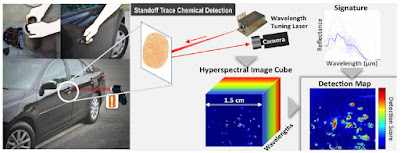Hyperspectral imaging, like many other of today's technologies, is moving into numerous commercial markets after developing and maturing in the defense sector. While still having a strong presence in defense applications, the technology is now used in chemical detection, food quality assurance and inspection, vegetation monitoring, and plant phenotyping, among others.
For more than 20 years, advances in spectral imaging have been on display at SPIE Defense + Commercial Sensing (DCS). The applications and capabilities of the technology have grown along with the conferences and exhibition at SPIE DCS.
The ability to see more than what is visible to the human eye has always been one of the goals of optical engineers. With hyperspectral imaging they have been able to achieve just that. By accessing the entire electromagnetic spectrum, the sensors are able to image a specific wavelength range, or spectral band, and combine images of multiple bands into one 3D scene.
Through analysis, differences between the spectral bands can be found and interpreted. This is useful because materials — whether gasses, vegetation, minerals,or whatever — leave unique spectral signatures in particular portions of the electromagnetic spectrum.
Food Quality and Inspection
SPIE DCS conference chair and CEO of Headwall Photonics David Bannon has been at the forefront of the transformation of hyperspectral imaging from DOD to commercial applications.
Headwall’s sensors have been on drones flying over everything from war zones to crop fields, as well as in processing facilities for cranberries, apples, and other food products. Being able to detect defects or grade food in real time as it goes down a conveyor belt has been a great tool in ensuring our food quality standards are met and waste is mitigated.
Remote Sensing
Many of these sensors have been put on satellites and are currently orbiting Earth in a variety of remote sensing applications. While the amount of data acquired from these satellites is great from an information perspective, from a data management and evaluation perspective the sheer amount can be daunting.
Decartes Labs' Daniela Moody, a 2017 SPIE Rising Researcher, has created algorithms to take petabytes of remote sensing data and create maps of vegetation and crop distributions in a given area. Highlighting corn and soy distribution in an area of Iowa and Brazil, respectively, in her presentation at SPIE DCS 2017.
(See the SPIE Digital Library proceedings paper to learn more).
The same hyperspectral technologies used for identifying large swaths of vegetation can also be used for identifying differences in individual plant specimens. One such example, presented at SPIE DCS 2017, was aimed at finding maize seedlings that could withstand cold weather for future strain development. The research was able to determine that particular wavelengths are better for maize phenotyping than others and that full wavelength scans were not needed, providing great data points for future studies.
 |
| The average spectral reflectance for different genotypes under the same condition: (a) controlled and (b) cold stressed. |
(See the SPIE Digital Library proceedings paper to learn more.)
Gas and Chemical Sensing
One of the more direct connections to the original defense applications of hyperspectral imaging is the ability to sense trace amounts of chemicals from a distance. This is especially important for law enforcement, border security, and intelligence community applications. Researchers have been generating libraries of spectral signatures of hazardous chemicals to be used by device makers and investigators alike. Speed and accuracy are of utmost importance in these applications and researchers presented a comparative study on a number of the available algorithms at SPIE DCS 2017.
 |
| Notional depiction of standoff trace chemical detection in a realistic application-relevant environment. |
See the SPIE Digital Library proceedings paper to learn more.)
Long-time attendees of SPIE Defense + Commercial Sensing have seen first-hand the evolution of hyperspectral sensing and have watched its applications grow.
In 1994, there was one conference, Algorithms for Multispectral and Hyperspectral Imagery, and a few companies on the exhibition floor with actual products using the entire spectrum of a scene.
In 2018 the original conference will return for its 24th installment, building on the addition of ultraspectral imagery in 2000, as the ability to add more lines became possible.
In addition, SPIE DCS now has conferences in Next-Generation Spectroscopic Technologies, in its 11th year, and a new conference focused on standards for commercialization, Hyperspectral Imaging Sensors: Innovative Applications and Sensor Standards.
All three of these conferences are currently accepting abstracts for the 2018 symposium, which is sure to continue the long history of bringing the latest and greatest from this growing field. SPIE Defense + Commercial Sensing 2018 will run 15 through 19 April in Orlando, Florida.


Comments
Post a Comment